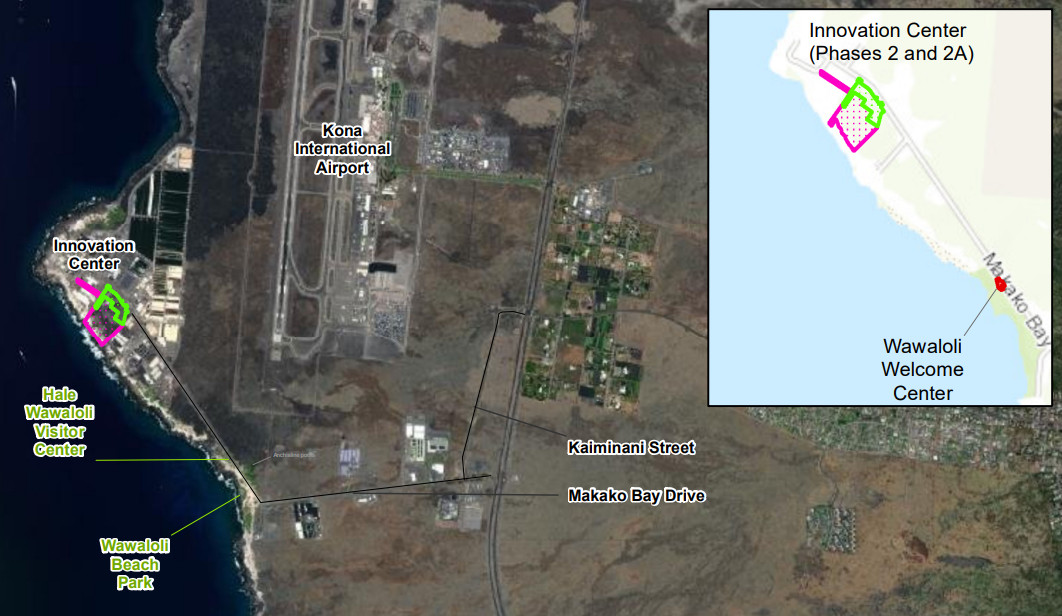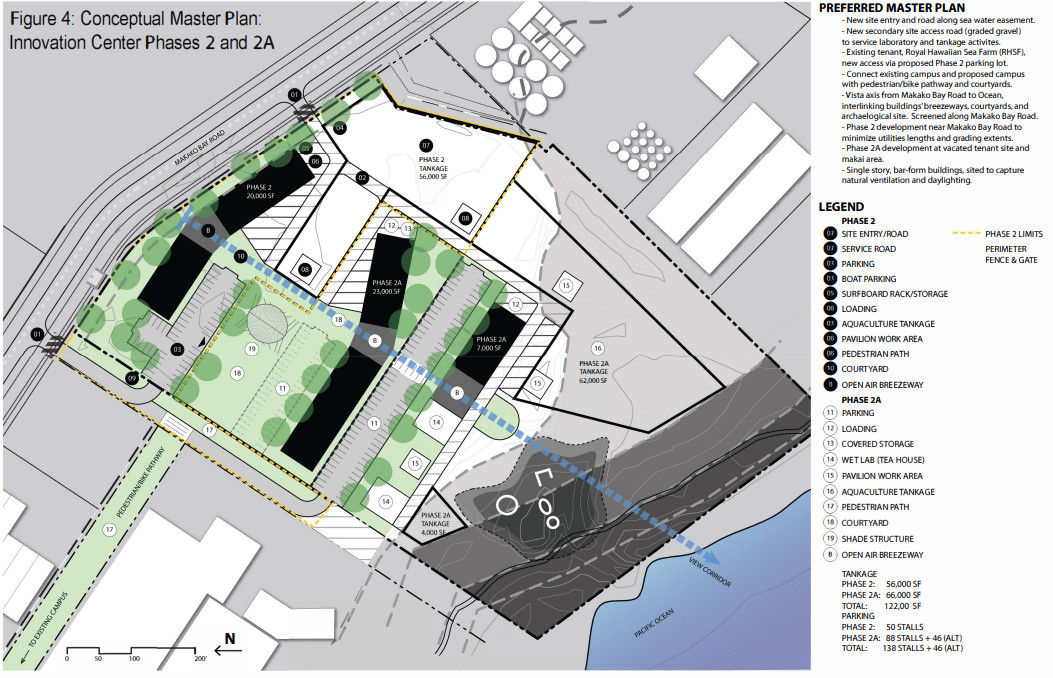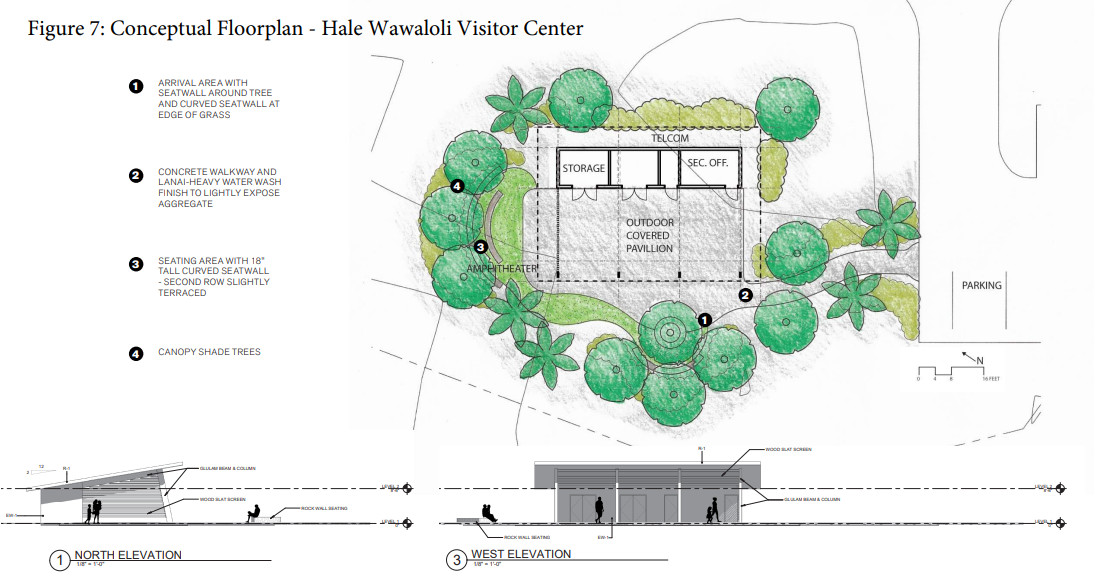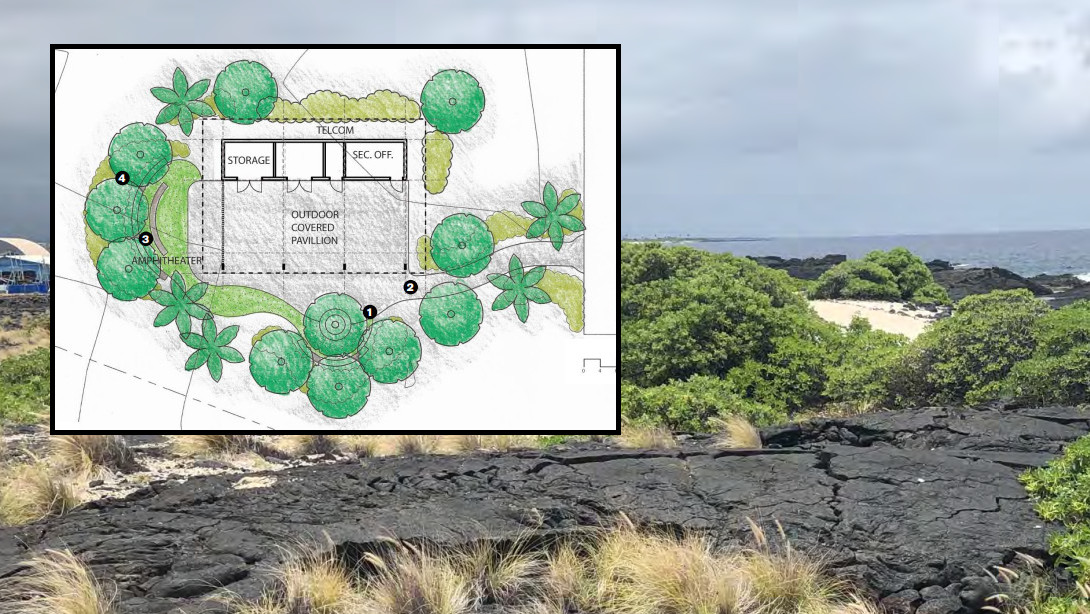
From Figure 1: Project Location Map from the Final Environmental Assessment for NELHA’s Innovation Center and Hale Wawaloli Visitor Center
(BIVN) – The Final Environmental Assessment for an expansion of the Research Village at the Natural Energy Laboratory of Hawaiʻi Authority, as well as a new visitor center for Wawaloli Beach Park, has been published with a Finding of No Significant Impact.
The Final EA examines the impacts of building a new Innovation Center at NELHA, in an area located just southwest of the Kona International Airport, and notes that the “current research facility is essentially at full capacity and the expansion would provide for program growth for the foreseeable future.” The Innovation Center would include offices, conference spaces, laboratories, indoor and outdoor research spaces, and meeting areas, the document says.

from the Final Environmental Assessment for NELHA’s Innovation Center and Hale Wawaloli Visitor Center
The Hale Wawaloli Visitor Center for the Hawaiʻi Ocean Science and Technology Park is also being planned to “serve as NELHA’s shoreline visitor education center” at Wawaloli Beach Park. It would include an outdoor covered pavilion, an open amphitheater space for community gatherings and public events, and three enclosed spaces, the document states.

from the Final Environmental Assessment for NELHA’s Innovation Center and Hale Wawaloli Visitor Center
“The proposed project has been designed to complement the visual character of the area and minimize impacts to coastal resources,” the final EA says.
NELHA, the proposing and determining agency for the EA, detailed the factors that were considered in determining the FONSI, or Finding Of No Significant Impact:
1. Irrevocably commit a natural, cultural, or historic resource. No valuable natural or cultural resources would be committed or lost as a result of the Proposed Project. One relatively rare plant, maiapilo, is present on the Innovation Center site. This plant will be avoided, and new maiapilo will be used for landscaping. An archaeological site adjacent to the Innovation Center will be protected during construction and operation of the facility.
2. Curtail the range of beneficial uses of the environment. The Proposed Project expands the beneficial uses of the environment and is consistent with the General Industrial and Open district zoning in the LUPAG.
3. Conflict with the State’s environmental policies or long-term environmental goals established by law. The State’s long-term environmental policies are set forth in Chapter 344, HRS. The broad goals of this policy are to conserve natural resources and enhance the quality of life. The impact from the Proposed Project is minor and, therefore, is consistent with all elements of the State’s long-term environmental policies and environmental goals.
4. Have a substantial adverse effect on the economic, social welfare, or cultural practices of the community or State. The State’s long-term environmental policies are set forth in Chapter 344, HRS. The broad goals of this policy are to conserve natural resources and enhance the quality of life. The Project is minor and fulfills aspects of these policies calling for an improved environment. It is thus consistent with all elements of the State’s long-term environmental policies. The Proposed Project would also generate employment opportunities for the local research and development industry, which would stimulate local economic spending.
5. Have a substantial adverse effect on public health. The Proposed Project would not affect public health in any way; stormwater would be appropriately disposed of in drainage structures.
6. Involve adverse secondary impacts, such as population changes or effects on public facilities. No adverse secondary effects are expected from the Project.
7. Involve a substantial degradation of environmental quality. The impact from the Proposed Project is minor and would thus not contribute to environmental degradation. BMPs and appropriate erosion control measures would be utilized during construction. No long-term adverse impacts are expected from the Proposed Project.
8. Is individually limited but cumulatively has substantial adverse effect upon the environment or involves a commitment for larger actions. The Proposed Project is not related to other activities in the region in such a way as to produce adverse cumulative effects or involve a commitment for larger actions. It is consistent with the projects analyzed in previous EISs that analyzed cumulative impacts of long-term operation and expansion of NELHA operations and contemplated in NELHA’s Master Plan.
9. Have a substantial adverse effect on a rare, threatened, or endangered species, or its habitat. There are no threatened or endangered species or suitable habitat for these species present at the Project Site, and no effects to these species are anticipated. Project impacts to maiapilo, a rare plant species, would be avoided. Endangered Hawaiian hoary bats and formerly listed Hawaiian hawks, which are island wide-ranging species, would experience no adverse impacts due to mitigation in the form of timing of vegetation removal. Additionally, no rare, threatened, or endangered species of fauna are known to exist on or near the Project Site, and none would be directly affected by any project activities. Potential impacts to Hylaeus anthracinus would be avoided since the Project would not disturb any Coastal Strand vegetation during construction of the Innovation Center property or the Hale Wawaloli Visitor Center, and the proposed fence at the Innovation Center would be routed around some isolated tree heliotrope and naupaka plants.
10. Have a substantial adverse effect on air or water quality or ambient noise levels. No adverse effects on air quality, water quality, or noise would occur. The increase in noise levels on the Project Site are consistent with their zoning and current use. The on-going CEMP would continue to ensure that no impacts to the nearshore environment occur from activities at NELHA or the HOST Park, including the Proposed Project.
11. Have a substantial adverse effect on or is likely to suffer damage by being located in an environmentally sensitive area such as a floodplain, tsunami zone, sea level rise exposure area, beach, erosion-prone area, geologically hazardous land, estuary, fresh water, or coastal waters. Although the property is located in an area with volcanic and seismic risk, the entire Island of Hawai‘i shares this risk, and the Proposed Project is not imprudent to construct. The Project Site is adjacent to the shoreline, but development for Phase 2 of the Innovation Center and the Hale Wawaloli Visitor Center is outside any flood plain. Based on potential impacts from climate change, the Proposed Project has been designed to
accommodate increased stormwater run-off from larger storms in the adjacent drainages and on site.12. Have substantial adverse effect on scenic vistas and viewplanes, during day or night, identified in county or state plans or studies. No scenic vistas and viewplanes identified in the Hawai‘i County General Plan will be adversely affected by the Proposed Project. Scenic effects to the shoreline have been avoided by project siting and design.
13. Require substantial energy consumption or emit substantial greenhouse gases. The Project includes measures to conserve energy, including the use of cold ocean water for heat transfer in the air conditioning.


by Big Island Video News8:33 am
on at
STORY SUMMARY
KONA, Hawaiʻi - A new Innovation Center for NELHA, and Hale Wawaloli Visitor Center for the Hawaiʻi Ocean Science and Technology Park, are planned for the Kona shoreline.